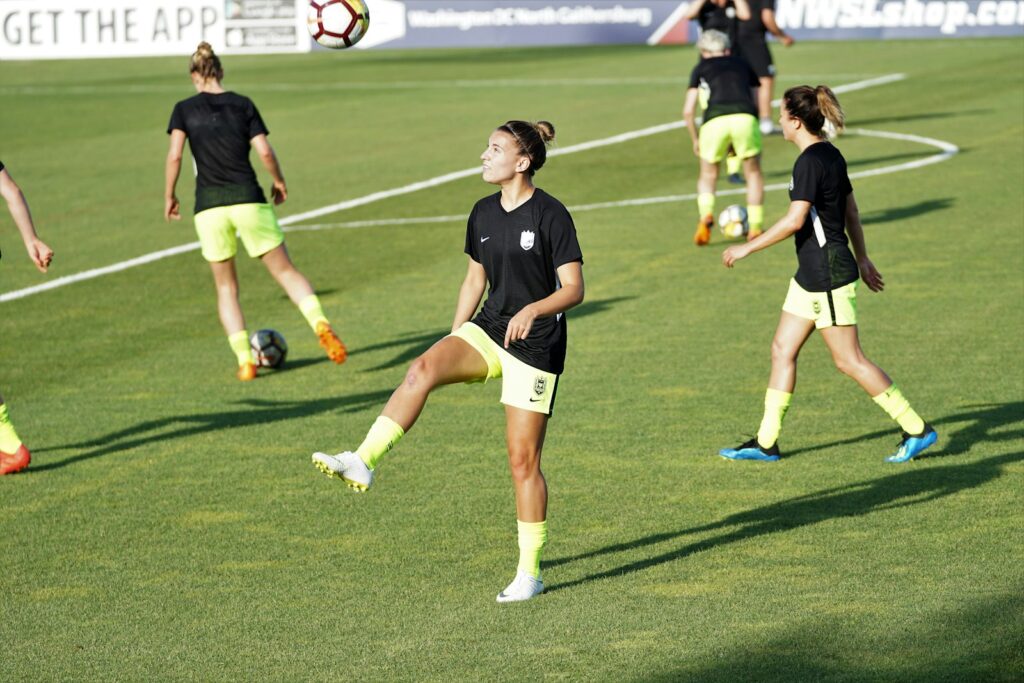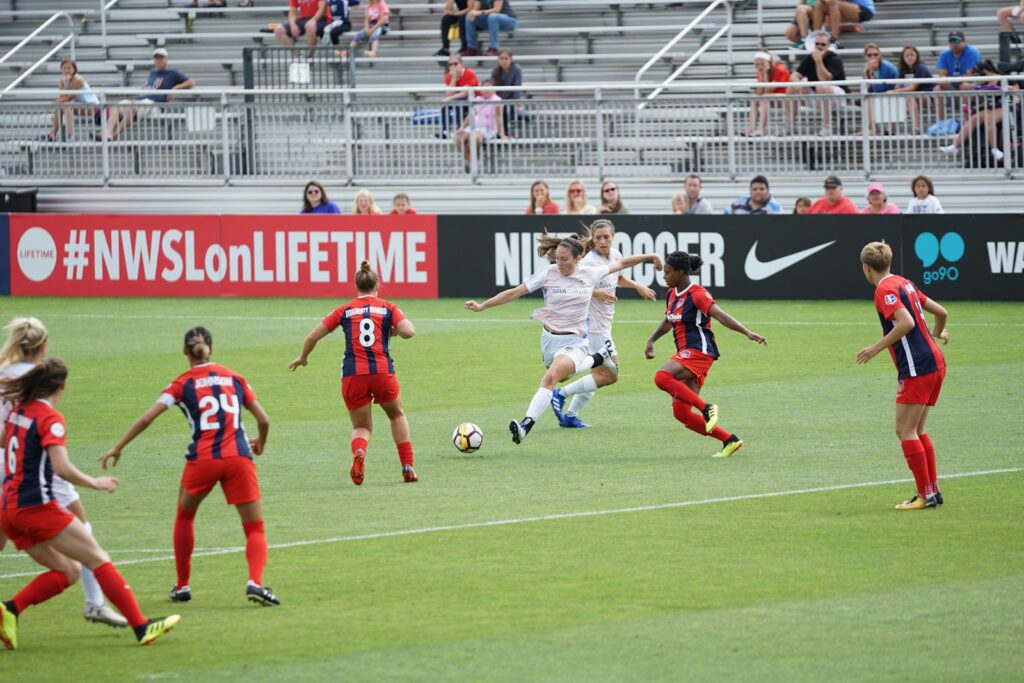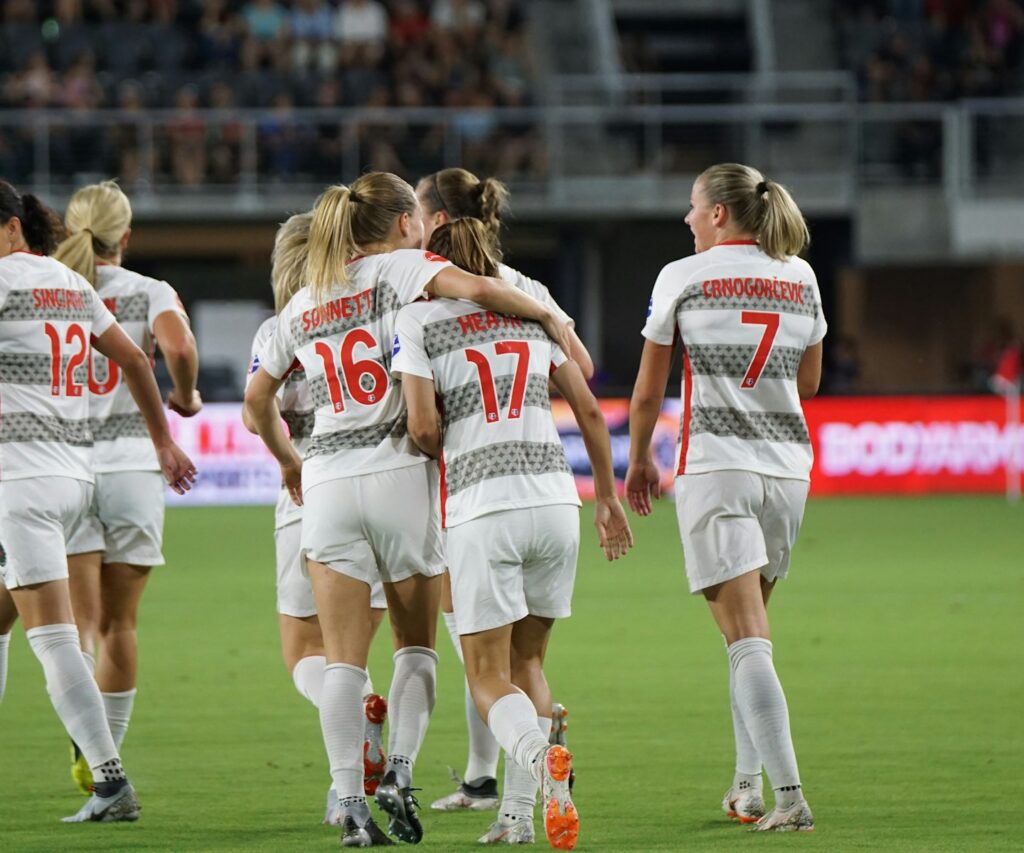Introduction
Imagine a green pitch beneath a stadium awash with cheering fans, the palpable excitement in the air, and that thumping heartbeat soundtracked by the roar of a crowd. This scene is no longer reserved for the men’s game in the United Kingdom; welcome to the meteoric rise of women’s football.
Once overshadowed by their male counterparts, the female footballers of the UK are now dazzling the nation with their skill, tenacity, and passion for the game, proving that the beautiful game knows no gender.
Women’s football in the UK has seen a surge in popularity and recognition, transforming from a grassroots movement into a professional sporting phenomenon. It’s a tale of breaking barriers and setting new standards, one that defies the notion of football being a man’s world. The aim of this article is to lace up our boots and embark on a journey through the growth and profound impact of women’s football in the UK.
From its humble beginnings to its current status as a burgeoning pillar of British sports culture, we’ll explore how these athletes have redefined what it means to play the game and in doing so, have changed the face of football itself.
The story of women’s football in the UK is rich with history, yet fraught with challenges. Female players have fought tirelessly to gain recognition and respect. To understand where we’re heading, it’s crucial to honor the past. The Women’s Super League (WSL), for instance, stands as a testament to the progress that has been made, offering a spotlight for the talent and potential that has long awaited its stage.
- Increasing Popularity: The sport’s popularity has skyrocketed, with more fans flocking to matches and tuning in than ever before.
- Recognition: Recognition for women’s football has grown in leaps and bounds, with the sport gaining newfound respect among fans and media alike.
- Impact Exploration: This article will delve into how the women’s game is shaping the future of football in the UK, inspiring the next generation and bringing fresh perspectives to the sport.
As we set the stage for this exploration, it’s clear that women’s football in the UK is not just a fleeting trend. It’s a movement that’s gaining momentum, capturing hearts and changing minds. With each goal scored and each barrier broken, the narrative of football is being rewritten. And it’s about time we turned the spotlight on these trailblazers. Join us as we take a closer look at the beautiful game through a refreshed lens, one that’s vibrant with the spirit of women’s football.
The History of Women’s Football in the UK

The roots of women’s football in the United Kingdom are deep and tangled, with a history as rich as it is rocky. Imagine a time when the very idea of women taking to the pitch was met with raised eyebrows and societal tsk-tsks.
Despite an auspicious start during the First World War, where female munitions workers formed teams to play in charity matches, women’s football was shoved to the sidelines by the Football Association’s (FA) 1921 ban on the game being played on FA-affiliated grounds. This ban, a heavy tackle against the growing popularity of the women’s game, was not lifted for a staggering fifty years.
- The Dick, Kerr Ladies: One of the earliest and most renowned teams, they drew crowds of 50,000+ in the 1920s, shattering the glass ceiling with their boots laced tight.
- The Ban of 1921: A dark period for women’s football where the FA cited the unsuitability of the game for women as a pretext to outlaw it on their grounds.
- The Resilience and Growth Post-Ban: Despite the ban, women’s football survived in the grassroots, an ember that refused to be snuffed out, slowly gaining momentum once more.
Fast forward to the swings and disco of the 1970s, women’s football in the UK began to find its feet again. The ban was finally lifted in 1971, allowing the seeds of the modern game to be sown. The formation of the Women’s Football Association (WFA) in 1969 marked a turning point, spearheading the first unofficial national competitions and fighting for the sport’s recognition.
However, it wasn’t until 1991 that the FA took the women’s game under its wing, leading to the establishment of the FA Women’s Premier League in 1992. A pivotal milestone came with the founding of the Women’s Super League (WSL) in 2011, the first semi-professional women’s football league in England, which has been a catalyst for professional standards, media attention, and commercial interest. The WSL has been instrumental in not just promoting, but also advancing women’s football, offering a platform for talent to shine and changing the face of the sport in the UK.
- The Lift of the Ban: In 1971, the FA’s decision to lift the 1921 ban breathed new life into women’s football.
- Women’s Football Association (WFA): Founded in 1969, this organization was pivotal in organizing competitions and advocating for women’s football.
- FA Women’s Premier League: Launched in 1992, it replaced the WFA’s league and aligned more closely with the FA’s governance.
- Women’s Super League (WSL): Established in 2011, it marked a new era of semi-professionalism and visibility for the women’s game.
The journey of women’s football in the United Kingdom has been a tale of persistence against the odds, a narrative that reminds us of the sport’s power to unite and defy. From being banished from the stadiums to broadcasting live on national television, the women’s game has proven that passion and perseverance can turn the tide, allowing the sport to reclaim its rightful place in the pantheon of British football history.
Changing Perceptions of Women’s Football in the UK

Once upon a time, women’s football in the UK was like the neglected middle child—known to the family but not quite getting the attention it deserved. But, oh, how the times are a-changin’. The beautiful game, long considered the dominion of men, is now being redefined by the women who play it with as much passion, skill, and tenacity. With every sliding tackle and every net-bulging goal, female footballers are challenging the dusty stereotypes and rewriting the narrative.
The early image of women’s football was unfortunately marred by stereotypes and prejudices. These weren’t just whispers on the wind but bellowing voices claiming that women’s football was somehow less worthy of attention and respect than its male counterpart. But, like a team down by a goal with minutes to spare, women’s football has been mounting a remarkable comeback.
Players, coaches, and organizations, with the mettle of knights in shin guards, have taken up the gauntlet to challenge these misconceptions. They’ve been dribbling around biases, outpacing gender norms, and scoring goals for gender equality. Initiatives have sprouted like grass on well-tended pitches, aimed at propelling women’s football into the spotlight it so rightly deserves. The FA’s ‘Gameplan for Growth’, for instance, is a strategic beacon lighting the way for future stars of the sport.
- The ‘This Girl Can’ campaign, with its vibrant and empowering message, has not just kicked but volleyed the old image of women’s football out of the park.
- The ‘Women’s Football Weekend’ has turned up the volume on the sport, encouraging more fans to attend matches and engage with the game.
- Barclays’ sponsorship of the Women’s Super League has brought commercial clout that speaks volumes, saying that women’s football is indeed a force to be reckoned with.
These campaigns and others have painted women’s football not just in the colors of the teams but in the hues of inclusivity and progress. The once whispered conversations about women’s football are now loud dialogues, with more soccer moms and dads encouraging their little girls to lace up their boots and dream of scoring goals at Wembley.
Let’s not forget, the heroines of the 2019 Women’s World Cup were not just playing for the trophy but for the hearts and minds of fans and skeptics alike. The Lionesses roared, and the world listened, turning a spotlight on the UK’s female footballers like never before. This event wasn’t just a tournament; it was a cultural touchstone that helped solidify the respect for the women’s game.
So, while challenges still loom like a tough away fixture, the collective effort to change the perception of women’s football in the UK is the equivalent of a well-organized defense, ready to take on any opposition and come out on top. The sport has gone from being seen as an afterthought to an essential part of the football family, adored by a growing legion of fans and aspiring players, eager to bend it like their heroines.
The Growing Popularity of Women’s Football in the UK

Like a phoenix rising from the ashes, women’s football in the United Kingdom has soared in popularity, capturing the hearts of fans and igniting the spirit of the beautiful game in a way that’s reshaping football culture. The once overlooked sport is now basking in the spotlight, with an ever-increasing fanbase that’s as passionate and vocal as any.
The magnetism of this shift isn’t just felt in the packed stadiums or on vibrant social media channels; it’s echoed in the boardrooms of sponsors who are now keen to associate themselves with this burgeoning juggernaut.
- Fan Fervour: The terraces of women’s football matches are no longer scantily populated. The crowds have swelled, with attendance figures skyrocketing as supporters flock to witness the prowess and dynamism of female footballers. The echoes of cheers in stadiums are a testament to the growing appeal of the women’s game.
- Media Spotlight: Like moths to a flame, the media has turned its lenses towards women’s football, with coverage expanding exponentially. Matches are now regularly broadcasted, and the players grace the covers of magazines and newspapers, illustrating a paradigm shift in sports journalism.
- Impact of the 2019 Women’s World Cup: The ripple effects of the 2019 Women’s World Cup are still felt today. The tournament was a watershed moment, not just for the victorious teams, but for women’s football globally, especially in the UK. The lionesses’ roar was heard around the world, and with it came a surge in visibility and popularity for the sport.
It’s not just the numbers that tell the tale of this growing popularity; it’s the stories, the communities, and the shared experiences. Young girls and boys now have a myriad of female footballing heroes to emulate in schoolyards and local parks. The jerseys of female players are worn with pride, symbolizing a seismic shift in the landscape of football fandom.
However, this surge in popularity isn’t merely confined to the professional leagues. Grassroots movements and local clubs have seen an uptick in participation, with more and more female teams cropping up across the nation. This grassroots growth is the lifeblood of the sport, ensuring that the future of women’s football is not just bright but also sustainable and deeply rooted in the fabric of UK society.
The juggernaut that is women’s football in the UK shows no signs of slowing down. With each game, with each goal, and with every new fan, the sport writes a new chapter in its own thrilling saga. One thing is for certain: the game of football, as we know it, is being redefined, and women are at the helm of this exciting transformation.
The Impact of Women’s Football on the Game

The landscape of football is undergoing a seismic shift as women’s football in the United Kingdom continues to score goals not just on the pitch but in the very heart of cultural transformation. The rise of women’s football is not merely a subplot in the grand narrative of the sport but is rapidly becoming a cornerstone in redefining the beautiful game.
Where once the grass seemed greener on the men’s side of the fence, women’s football is cultivating its own lush field. The influence of the women’s game is palpable, starting from the grassroots level where young girls are now seeing football as a viable path to pursue. This grassroots and youth development is a crucial feeder for talent, passion, and a reimagined football culture that champions diversity and inclusion.
- Increased female participation at the youth level inspires a new generation of players, coaches, and fans.
- Development programmes specifically tailored for girls and women are mushrooming, providing the necessary skills and support.
- Role models in professional women’s football are becoming household names, creating aspirations that were once deemed unreachable.
In the realm of professional play, the effects are equally transformative. The women’s game is imbuing the sport with a fresh spirit and a new set of values that prize inclusion over exclusion, community over division, and empowerment over subjugation. Professional women’s teams are not just elevating the game technically and tactically, but they are also enhancing the cultural fabric of football by embracing a wider audience.
- Women’s teams are pioneering community outreach initiatives, strengthening bonds with local supporters.
- The establishment of more professional women’s teams offers greater opportunities for females in sport-related careers.
- These teams serve as beacons of gender equality, influencing attitudes both within and beyond the football sphere.
Yet, while the women’s game is leaping forward, it throws a spotlight on areas where the broader sport can evolve. Issues like diversity and inclusivity are becoming part of the main discourse, pushing football towards a more equitable future where every person, regardless of gender, can find their place and potential. This impact is not limited to the UK; it resonates on an international scale, setting an example for other nations to follow.
Challenges and Obstacles Faced by Women’s Football in the UK

Despite the cheering crowds and the undeniable skill lighting up pitches across the UK, not everything is a smooth sail in the world of women’s football. Female footballers in the United Kingdom continue to navigate a labyrinth of challenges that, unlike a defender’s tackle, cannot be dodged with a swift side-step.
One such challenge is the disparity in pay. While the men’s game boasts eye-watering salaries, women’s paychecks often seem like loose change in comparison. The gap is more than just monetary; it’s a symbol of the ingrained inequalities that women in the sport face daily.
The struggle doesn’t end with the pay slip. Media coverage is yet another hurdle. Although there’s been a surge in visibility post-2019 Women’s World Cup, the coverage still pales compared to the men’s game. Women’s football often finds itself relegated to the sidelines in sports news, fighting for the spotlight it rightfully deserves.
Moreover, the infrastructure and facilities provided to women’s teams often reflect an afterthought rather than a priority. From the shimmer of Wembley to the humblest of grassroots pitches, the disparity is clear as day. Many women’s teams are still waiting for their ‘Field of Dreams’ moment where facilities aren’t just adequate but inspirational.
- Pay Parity: The battle for equal pay is not just about money but recognition and respect.
- Media Coverage: Increased media attention is crucial for the growth of the sport and the empowerment of its athletes.
- Facilities: High-quality training grounds and stadiums are the seedbeds of future talent and professional performance.
Despite the obstacles, there’s a relentless drive within the women’s football community to push forward. Initiatives across the UK aim to level the playing field, such as campaigns for equal pay and better representation in sports media. There’s a growing movement that is kicking down the barriers, one goal at a time.
The challenges are as tough as an away game in the pouring rain, but the spirit of the players, coaches, and fans mirrors the tenacity of a team that knows victory is within reach. The fight for better pay, coverage, and facilities is more than a quest for equality; it’s the match that will define the future of the game.
As the full-time whistle approaches, one thing is clear: the growth of women’s football in the UK is unstoppable. But to ensure this isn’t just a fleeting moment of glory, it’s essential to continue addressing these challenges head-on. Only with sustained effort and investment can we hope to see a future where women’s football stands shoulder to shoulder with the men’s – not just on the pitch, but in every aspect of the beautiful game.
The Future of Women’s Football in the UK

As we gaze into the crystal ball of women’s football in the United Kingdom, the horizon gleams with promise, akin to the first golden rays of dawn that banish the shadows of a long night. The trajectory of the women’s game is arcing ever upwards, and there’s an electric air of anticipation for what is yet to unfold. But what specifically does the future hold for this burgeoning sphere of British sport?
Firstly, it’s important to recognize the seeds of potential that have been sown in recent years. These seeds are poised to blossom into spectacular showcases of athleticism, strategy, and community spirit. We’re talking about a period of unprecedented growth and opportunity, with several key indicators lighting the path forward.
- Major Tournaments on Home Turf: The UK is set to host a fleet of high-profile tournaments, including the UEFA Women’s Euro 2022. These events are not just spectacles of the sport; they are catalysts for inspiration, driving interest and participation among young girls and boys alike. A successful home tournament could ignite a love for the game in a new generation of footballers.
- Investment and Sponsorship: The scent of opportunity has attracted increased investment and sponsorship deals. These financial boosts are essential for the sport’s infrastructure, providing better training facilities, larger marketing budgets, and the potential for more competitive salaries.
- Community and Grassroots Initiatives: The roots of any sport are embedded in local communities. There’s a burgeoning movement to deepen the engagement at the grassroots level, ensuring that girls have access to football from a young age and can find role models in their local heroines on the pitch.
The landscape of women’s football is also seeing a shift in media representation. With broadcasting deals becoming more lucrative and widespread, the visibility of women’s football is set to soar, bringing with it greater endorsement opportunities and a platform for players to become household names.
Yet, as we look to the horizon, it’s clear that there’s no room for complacency. The future must be vigorously guarded through continued advocacy for gender parity, especially in areas such as media coverage and pay. Campaigns and dialogues must persist in challenging outdated notions and celebrating the women who make the beautiful game what it is.
- Advancing Pay Parity: The goal of achieving pay parity remains critical, with the hope that the commercial success of the sport will eventually translate into wages that reflect the players’ immense contributions.
- Enhanced Media Coverage: The narrative of women’s football deserves to be told with the same fervor as the men’s game. Expanding media coverage is essential in shaping public perception and bringing the sport into more living rooms across the UK.
- Facilities and Resources: Continued investment in top-notch facilities and resources will not only aid in player development but also send a strong signal about the value placed on women’s football.
In summation, the future of women’s football in the UK gleams with potential as bright as a stadium floodlight. It beckons us all—players, fans, coaches, and sponsors—to be a part of this exhilarating journey. As the sport continues to redefine itself, it paves the way for a legacy of diversity, inclusivity, and undiluted passion for the game. The ball is in our court, and it’s time to play forward with unwavering conviction for the love of football.
Conclusion
Ladies and gentlemen, as we draw the curtains on our exploration of women’s football in the UK, let’s take a moment to reflect on the vibrant tapestry we’ve woven through our discussion. We’ve embarked on an extraordinary journey from the early days when female footballers faced towering barriers to today’s burgeoning landscape, where women’s football is carving out its own indelible mark on the nation’s sporting culture. It’s not just a game; it’s a burgeoning narrative of empowerment and change.
We’ve seen how the tides have changed, with the Women’s Super League igniting a revolution and becoming a beacon of progression, inspiring young girls to lace up their boots and dream big. The 2019 Women’s World Cup was a watershed moment, not just a tournament, but a global stage that showcased the rising prowess and undeniable talent of women footballers, sparking an upsurge in popularity back home.
Let’s not forget the challenges – they are but the plot twists in this inspiring story. Pay parity, media coverage, and facilities: these are not just items on a to-do list; they are the hurdles to leap over as the sport sprints towards equity and recognition. Yet, with unwavering spirit and relentless dedication, the women’s football community continues to tackle these obstacles head-on, forging a path for future generations to walk – or rather, to run – with pride.
- Grassroots Triumphs: The sport’s impact at the grassroots level is like a seed sprouting into a mighty oak – steady, strong, and significant.
- Inclusivity Goals: Every goal scored in women’s football is more than a point on the scoreboard; it’s a strike for diversity and inclusion in the beautiful game.
- Investment Waves: The need for continued investment and support is the drumbeat to which the future of women’s football marches – loud and clear.
As we peer into the crystal ball for the future of women’s football in the UK, one thing is decidedly clear: the game is on the brink of a golden era. With upcoming events and dedicated initiatives, the sport is poised not just for growth but for a renaissance. It beckons a new era where the phrase “playing like a girl” is synonymous with playing with skill, heart, and an unyielding zest for victory.
In wrapping up, the impact of women’s football in the UK is not just a fleeting chapter in the annals of sports history; it’s an ongoing saga of transformation and triumph. The journey ahead is imbued with promise and potential, echoing a unison chant for more: more recognition, more support, and unapologetically, more football. So, as fans, supporters, and stewards of the game, let’s rally behind this cause, for the love of football and for the legacy it leaves for the dreamers yet to come.

